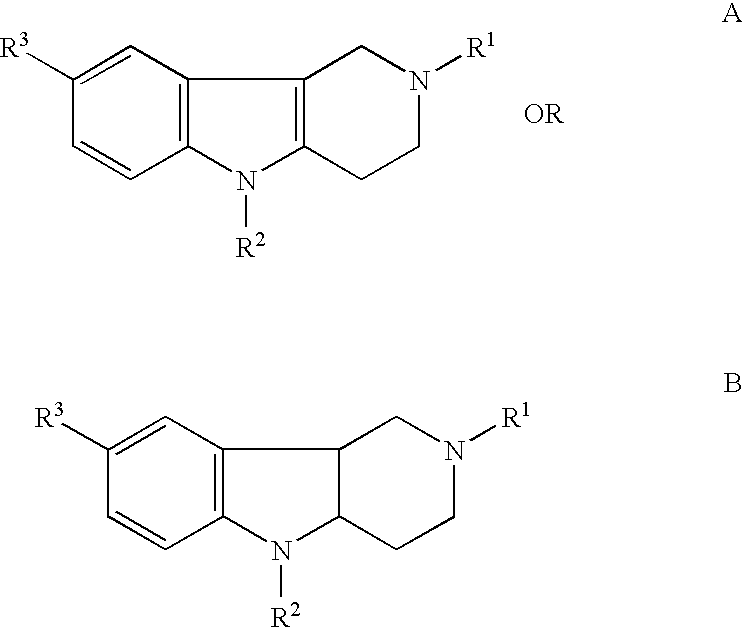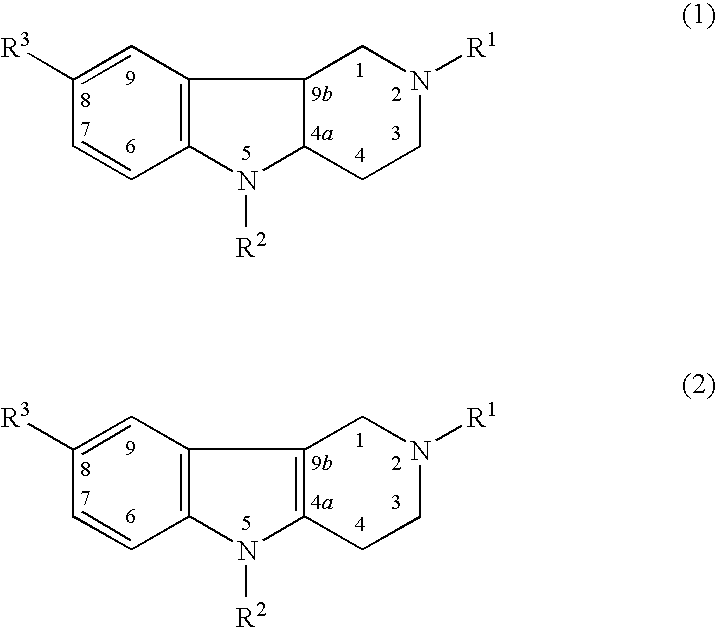Methods and combination therapies for treating alzheimer's disease
- Summary
- Abstract
- Description
- Claims
- Application Information
AI Technical Summary
Benefits of technology
Problems solved by technology
Method used
Image
Examples
example 1
Randomized, Double-Blinded, Placebo-Controlled Alzheimer's Disease Study Using Dimebon
[0158]Dimebon, 2,8-dimethyl-5-(2-(6-methyl-3-pyridyl)-ethyl)-2,3,4,5-tetrahydro-1H-pyrido(4,3-b)indol dihydrochloride, was used as a representative compound of hydrogenated pyrido (4,3-b) indoles and was found to improve cognition, function and behavior in human patients with Alzheimer's disease.
where R1 and R3 are methyls, and R2 is 2-(6-methyl-3-pyridyl)-ethyl.
[0159]In the study, 183 patients with mild to moderate Alzheimer's disease were randomized to dimebon (20 mg orally three times a day) or placebo for 6 months. Patients were evaluated with the ADAS-cog (primary endpoint), CIBIC-plus, MMSE, NPI and ADL at baseline, week 12 and week 26. The Alzheimer's Disease Assessment Scale Cognitive Subscale (ADAS-cog) score assesses memory and cognition over time. The Mini Mental State Exam (MMSE) also assesses memory and cognition. The Alzheimer's Disease Cooperative Study-Clinical Global Impression of ...
example 2
Double-Blind, Placebo-Controlled, Randomized Study to Obtain Extended Safety, Tolerability, and Preliminary Efficacy Assessments of Combination Therapy with Orally-Administered Dimebon and Donepezil for the Treatment of Alzheimer's Disease
[0162]The following study is conducted in two parts. The first is a placebo-controlled, randomized, within-patient dose titration study of the safety, tolerability, and pharmacokinetics of orally administered dimebon in Alzheimer's disease (“AD”) patients on the acetylcholinesterase inhibitor donepezil. The second is a double-blind, placebo-controlled, randomized study to obtain extended safety, tolerability, and preliminary efficacy assessments of orally-administered dimebon in AD patients on donepezil.
[0163]One objective of the first part of the study is to assess the safety and tolerability of orally-administered dimebon in patients with AD also taking a stable dosage of donepezil (marketed under the trade name Aricept®). Additional objectives o...
example 3
Use of an In Vivo Model to Determine the Ability to Combination Therapies of the Invention to Treat, Prevent and / or Delay the Onset and / or the Development of Alzheimer's Disease
[0187]In vivo models of Alzheimer's disease can also be used to determine the ability of any of the combination therapies described herein to treat, prevent and / or delay the onset and / or the development of Alzheimer's disease in mammals, such as humans. An exemplary animal model of Alzheimer's disease includes transgenic mice over-expressing the ‘Swedish’ mutant amyloid precursor protein (APP; Tg2576; K670N / M671L; Hsiao et al., 1996, Science, 274:99-102). The phenotype present in these mice has been well-characterized (Holcomb L A et al., 1998, Nat. Med., 4:97-100; Holcomb L A et al., 1999, Behav. Gen., 29:177-185; and McGowan E, 1999, Neurobiol. Dis., 6:231-244). Standard methods can be used to determine whether any of the combination therapies of the invention decrease the amount of Aβ deposits in the brain...
PUM
| Property | Measurement | Unit |
|---|---|---|
| Volume | aaaaa | aaaaa |
| Volume | aaaaa | aaaaa |
| Volume | aaaaa | aaaaa |
Abstract
Description
Claims
Application Information
 Login to View More
Login to View More - R&D
- Intellectual Property
- Life Sciences
- Materials
- Tech Scout
- Unparalleled Data Quality
- Higher Quality Content
- 60% Fewer Hallucinations
Browse by: Latest US Patents, China's latest patents, Technical Efficacy Thesaurus, Application Domain, Technology Topic, Popular Technical Reports.
© 2025 PatSnap. All rights reserved.Legal|Privacy policy|Modern Slavery Act Transparency Statement|Sitemap|About US| Contact US: help@patsnap.com



